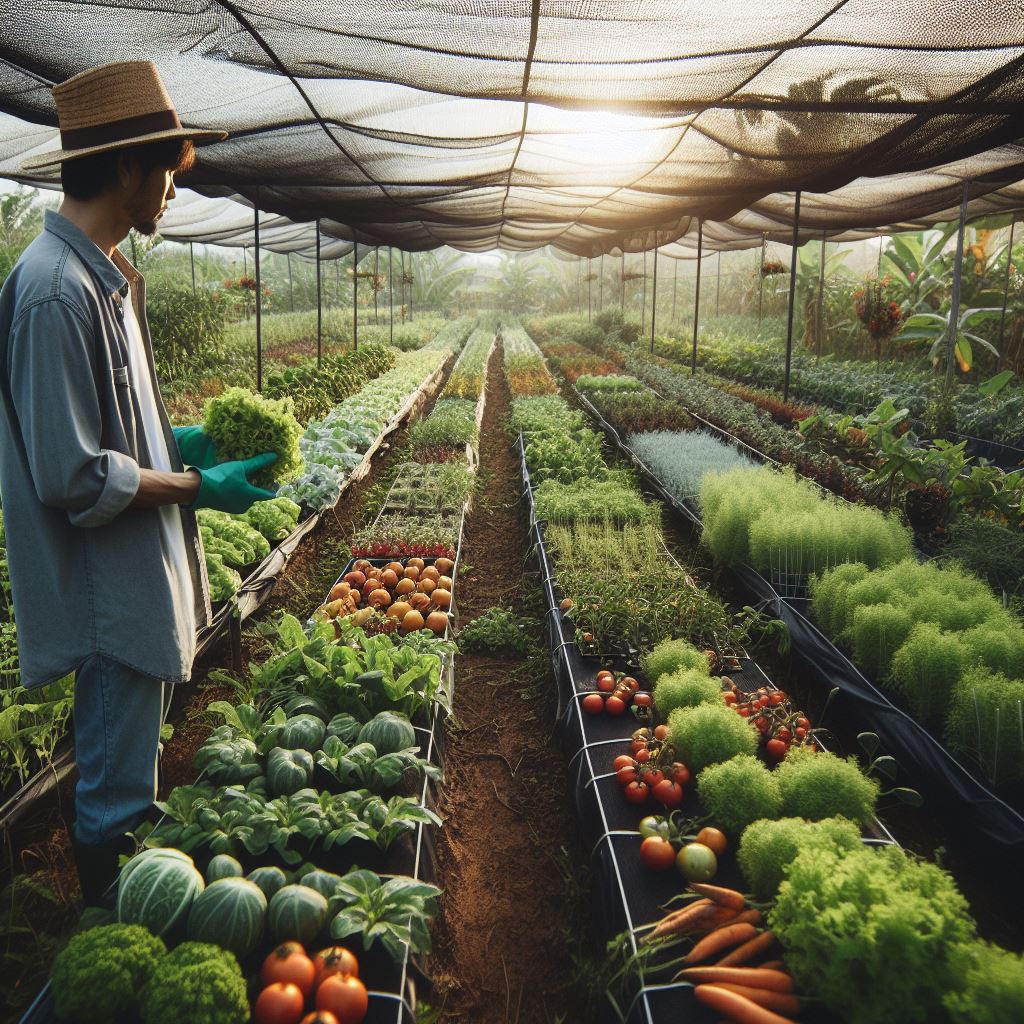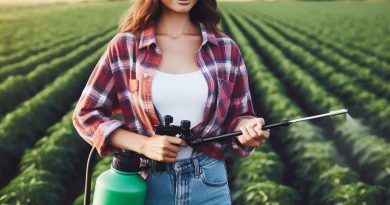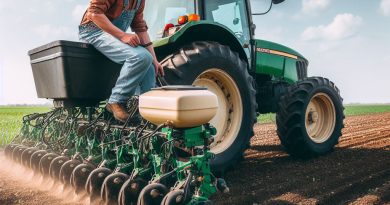Managing Pests in Organic Farming
Last Updated on March 5, 2024
Introduction
Managing pests in organic farming is crucial to ensure the success and sustainability of the practice. Organic farming is a method that relies on natural processes and avoids the use of synthetic chemicals.
Despite its many benefits, organic farming faces challenges in effectively managing pests.
Importance of managing pests in organic farming
Pests pose a significant threat to organic farming, jeopardizing crop yields and profitability. Organic farming aims to create a harmonious balance between nature and agriculture.
By implementing organic farming principles, farmers preserve ecosystem health and promote biodiversity. One of the biggest challenges in organic pest management is the limited range of pest control options available.
Without the use of synthetic chemicals, organic farmers rely on preventive measures and biological pest control.
Definition of organic farming and its principles
Crop rotation and diversification are essential strategies in organic pest management. These practices disrupt pests’ life cycles and reduce the risk of pest infestations.
However, maintaining a healthy balance between crops and pests can be challenging. Under favorable conditions, pests can multiply rapidly and cause substantial damage to organic crops.
Overview of the challenges faced in organic pest management
To address this issue, organic farmers employ various pest monitoring techniques, such as trap crops and pheromone traps. These methods help farmers identify and track pest populations, enabling timely intervention.
In organic farming, prevention is key. Farmers focus on creating healthy soil and strong, robust plants. Enhancing soil fertility and plant nutrition are fundamental components of organic pest management.
By providing plants with optimal growing conditions, they become more resistant to pest attacks. Additionally, organic farmers often promote beneficial insects that act as natural enemies to pests.
Ladybugs, lacewings, and parasitic wasps are commonly introduced to control pest populations. In managing pests in organic farming is a critical aspect of maintaining productivity and preserving ecological balance.
Organic farmers face unique challenges but find innovative and sustainable solutions for effective pest management.
Identification and Monitoring of Pests
Importance of Accurate Pest Identification
Accurate pest identification is the foundation of effective pest management in organic farming. mIt allows farmers to understand the specific pests they are dealing with, their behavior, and lifecycle patterns.
This knowledge is essential for making informed decisions regarding the appropriate control methods. In the absence of synthetic pesticides in organic farming, pest identification becomes even more crucial.
Organic farmers rely on various non-chemical control measures such as biological agents, cultural practices, and physical barriers. Each of these methods targets specific pests, and accurate identification ensures that the control measures are applied correctly.
Different Monitoring Techniques for Pests
Visual inspections are one of the simplest yet valuable pest monitoring techniques. By regularly observing plants, farmers can spot initial signs of pest infestation.
Chewed leaves, holes, wilting, or discoloration can indicate the presence of pests. Early detection allows farmers to take immediate action, preventing pests from causing significant damage.
Traps and pheromone lures are also widely used for pest monitoring. These tools attract pests, capturing them for identification or monitoring purposes. Sticky traps can catch flying insects, while pitfall traps are efficient in capturing crawling pests.
Pheromone traps release specific scents that lure pests, providing valuable data on their population size and movement patterns. Advancements in technology have introduced innovative pest scouting apps and digital tools.
These tools allow farmers to take photos of pests or plant symptoms and use machine learning algorithms for accurate identification. Pest scouting apps can also track pest populations over time, helping farmers make data-driven decisions regarding control strategies.
Accurate pest identification is of utmost importance in organic farming. It forms the basis for effective pest management strategies that align with organic principles.
Visual inspections, traps and lures, as well as pest scouting apps and digital tools, play vital roles in monitoring pests.
By actively monitoring and identifying pests, organic farmers can implement timely and targeted control measures, ensuring the health and productivity of their crops while minimizing the use of synthetic pesticides.
Read: Eco-Friendly Pest Control in Farming
Prevention and Cultural Practices
Importance of preventive measures in organic pest control
- Preventive measures are crucial for effectively managing pests in organic farming.
- By implementing preventive strategies, farmers can reduce the need for synthetic pesticides.
- This approach fosters long-term sustainability by promoting natural ecosystem functions.
- Preventive measures build resilient crops that can withstand pest pressures and minimize crop loss.
- Moreover, preventive practices also protect the environment and human health.
Crop rotation and diversity
- Crop rotation is a fundamental cultural practice that disrupts pest life cycles.
- Changing the type of crop grown in a field helps break the pest’s reproductive cycle.
- Rotating crops also improves soil health, reduces soil-borne diseases, and boosts nutrient availability.
- Diversifying crop species decreases pest vulnerability as certain pests are specific to certain plants.
- By enhancing biodiversity, natural predators and beneficial insects thrive, controlling pest populations.
Soil management and nutrient balance
- Healthy soil is the foundation of organic pest management.
- Maintaining soil fertility through proper management practices minimizes pest infestation.
- Regular soil testing helps assess nutrient deficiencies and adjusts amendments accordingly.
- Optimal nutrient balance ensures plants’ vigor and resilience, reducing their attractiveness to pests.
- Amending soils with compost and organic matter improves the soil structure and promotes beneficial microbes.
Companion planting and intercropping
- Companion planting involves growing compatible plants near susceptible crops to deter pests.
- Some plant combinations repel pests, others attract beneficial insects, creating a natural balance.
- Intercropping, growing different crops together, confuses pests and reduces their ability to locate host plants.
- Planting aromatic herbs like basil or marigold alongside vegetables can repel certain pests.
5.These practices encourage biodiversity, enhance pollination, and maximize land utilization.
Proper spacing and cultivation techniques
- Maintaining proper spacing between plants allows airflow, reducing humidity and preventing pest-friendly environments.
- Crowded plants are more prone to disease, attracting pests, and hindering natural pest control.
- Weeding and removing crop residues promptly deprive pests of hiding places and breeding sites.
- Practicing good hygiene by cleaning farm equipment prevents the spread of pests and diseases.
- An organized farm layout and clear pathways enable easier monitoring and identification of potential pest issues.
By adopting preventive measures and implementing cultural practices, organic farmers can effectively manage pests while promoting a sustainable and environmentally friendly farming system.
These practices not only minimize the use of synthetic pesticides but also contribute to the overall health and resilience of crops.
Through crop rotation and diversity, farmers disrupt pest life cycles, reduce diseases, and enhance beneficial insect populations.
Proper soil management and nutrient balance improve plant health, while companion planting and intercropping create natural pest controls.
Additionally, attention to spacing and cultivation techniques maintains optimal plant conditions and reduces pest vulnerability.
Ultimately, preventive measures and cultural practices are essential components of successful organic pest management, ensuring the long-term viability of organic farming systems.
Read: Optimizing Soil Fertility: Advanced Tips

Natural predators and beneficial insects
Introduction to natural enemies in organic pest control
In organic farming, natural predators and beneficial insects play a crucial role in managing pests.
These organisms provide a chemical-free and sustainable solution to keep pest populations in check.
Common beneficial insects and their prey-predator relationships
- Ladybugs: These voracious beetles prey on aphids, mites, and other soft-bodied pests. They can consume hundreds of aphids in a single day.
- Lacewings: Lacewing larvae actively hunt and feed on aphids, caterpillars, and other pests, effectively controlling their populations.
- Parasitic wasps: These tiny wasps lay eggs on or inside pests like caterpillars and aphids, causing their demise and preventing further damage to crops.
- Ground beetles: These nocturnal insects feed on slugs, cutworms, and other soil-dwelling pests, providing natural pest control in the field.
Strategies to attract and maintain beneficial insects in the farm
- Diverse plantings: Growing a wide variety of flowering plants, herbs, and grasses attracts beneficial insects by providing a diverse food source and habitat.
- Avoiding pesticides: Chemical pesticides kill not only pests but also beneficial insects. Minimizing pesticide usage fosters the growth of natural predators.
- Providing water sources: Incorporating water features or small ponds in the farm attracts beneficial insects that require water for survival and reproduction.
- Providing shelter: Creating sheltered areas such as hedgerows, insect hotels, and cover crops offer refuge and nesting places for beneficial insects.
Utilization of trap crops and sacrificial plants
- Trap crops: Planting specific crops that pests are attracted to diverts them away from the main crops. For example, planting marigolds attracts nematodes and protects other plants.
- Sacrificial plants: These plants, which are highly attractive to pests, are strategically placed in the field to lure pests away from crops that are intended for harvest.
Natural predators and beneficial insects are a valuable asset in organic pest control. Understanding their role and implementing strategies to attract and maintain them on the farm can significantly reduce the reliance on chemical pesticides.
By utilizing techniques like trap crops and sacrificial plants, organic farmers can minimize crop damage while promoting a healthy and sustainable farming ecosystem.
Read: Seasonal Soil Care for Maximum Yield
Organic pest control methods
Achieving effective pest control in organic farming is essential to maintain crop health and maximize yields.
Organic farmers rely on a range of pest control methods that are sustainable and environmentally friendly.
Biological control using microbial agents.
One method of pest control in organic farming is biological control, which involves the use of microbial agents.
These agents are natural enemies of pests, such as bacteria, fungi, viruses, and nematodes.
Microbial agents attack and kill pests, reducing their populations without harming beneficial organisms or the environment.
For example, some bacteria produce toxins that target specific pests, while others compete directly with pests for food and space.
The use of microbial agents in organic farming requires careful selection and application to ensure their effectiveness.
Farmers often introduce these agents early in the crop cycle to prevent pest populations from becoming established.
Use of botanical insecticides and natural extracts
Another approach to organic pest control is the use of botanical insecticides and natural extracts.
These include plant-derived compounds that have insecticidal properties and can be used to control pests.
For example, pyrethrum, derived from chrysanthemum flowers, is a common botanical insecticide that disrupts the nervous systems of insects.
Neem oil, derived from the neem tree, also has insecticidal properties and can be used to control a wide range of pests.
Botanical insecticides and natural extracts provide effective pest control while minimizing harm to beneficial insects, birds, and mammals.
These natural alternatives are readily biodegradable and leave no harmful residues on crops or in the environment.
Integrated Pest Management (IPM) approach
Integrated Pest Management (IPM) is an approach that combines various pest control strategies to achieve sustainable and effective pest management in organic farming.
IPM involves monitoring pests and their populations, setting economic thresholds for intervention, and implementing control measures that prioritize the use of non-chemical methods.
This approach aims to minimize the use of synthetic pesticides while maximizing the benefits of biological control and other organic pest control methods.
By using IPM, organic farmers can strike a balance between pest control and environmental preservation.
This approach accounts for the complex interactions between pests, crops, and the environment, resulting in long-term pest management solutions.
Introduction to physical barriers and exclusion techniques
Physical barriers and exclusion techniques are important components of organic pest control.
These methods prevent pests from accessing crops, reducing the need for chemical interventions.
Physical barriers include fences, netting, and screens that create a barrier between crops and pests.
These barriers can be used to protect individual plants or entire fields, preventing pests from causing damage.
Exclusion techniques involve the use of physical structures or practices that make it difficult for pests to enter crop areas.
Examples include row covers, which protect plants from insect pests, and mulching, which creates a barrier against weed growth and limits pest habitats.
Organic-approved insect traps and lures
Organic-approved insect traps and lures provide an effective and environmentally friendly way to monitor and control pests in organic farming.
Insect traps use attractive baits or pheromones to lure pests, capturing them for removal or monitoring purposes. These traps can help farmers identify pest populations and determine the appropriate time to implement control measures.
Similarly, lures release specific pheromones that attract pests, disrupting their mating patterns and reducing their populations. This approach is especially useful in controlling pests that rely on pheromones for reproduction, such as moths.
Using organic-approved insect traps and lures allows farmers to target specific pests while minimizing the use of chemical pesticides. These methods are environmentally friendly, selective, and compatible with organic farming principles.
Effective pest control in organic farming relies on a variety of methods that prioritize sustainability and environmental preservation.
Biological control, botanical insecticides, IPM, physical barriers, and organic-approved traps are all essential tools for managing pests naturally and maintaining the health and productivity of organic crops.
Challenges and limitations in organic pest management:
Weather and environmental factors
- Organic farming is highly influenced by weather conditions such as temperature, humidity, and rainfall.
- Unfavorable weather can lead to the rapid spread of pests and diseases in organic farms.
- Extreme weather events like droughts or floods can disturb the ecological balance, affecting natural pest control mechanisms.
- Organic farmers must constantly monitor and adapt their pest management strategies according to changing weather patterns.
Lack of organic-approved pesticides for severe outbreaks
- Organic farmers face limitations when dealing with severe pest outbreaks as there are few approved organic pesticides available.
- Organic pesticides are generally less effective in controlling pests compared to conventional ones.
- Some severe outbreaks may require immediate action that cannot be fully addressed by organic alternatives.
- Finding effective and Organic Materials Review Institute (OMRI)-listed pesticides for specific crops and pests can be challenging.
Monitoring and detecting pest populations
- Identifying and monitoring pest populations accurately is crucial for effective pest management in organic farming.
- Regular field inspections, trap crops, and pheromone traps are commonly used methods.
- However, some pests may be difficult to detect early, leading to higher population levels and increased damage.
- Constant vigilance and proactive scouting are essential to successfully manage pests in organic farms.
The balance between pest control and ecological sustainability
- Organic pest management aims to maintain a balance between controlling pests and preserving ecological sustainability.
- Strict reliance on pesticides can negatively impact beneficial insects and disrupt ecological interactions.
- Integrated Pest Management (IPM) practices, such as crop rotation, biological control, and habitat diversification, are essential.
- Balancing the need for pest control while minimizing environmental impacts requires careful planning and continuous evaluation.
Managing pests in organic farming presents several challenges and limitations. Weather and environmental factors play a significant role in pest outbreaks and control measures.
The lack of organic-approved pesticides for severe infestations can pose difficulties for organic farmers. Monitoring and detecting pest populations accurately are essential but can be challenging.
Lastly, striking a balance between pest control and ecological sustainability is crucial for successful organic pest management.
Therefore, organic farmers must constantly adapt and evaluate their strategies to effectively manage pests while maintaining the integrity of their organic farming practices.
Read: High-Tech Soil Analysis for Farmers
Conclusion
Recap of key points discussed in the blog post
Throughout this blog chapter, we have explored the challenges faced by organic farmers in managing pests. We began by understanding the concept of organic farming and its reliance on natural processes to maintain soil health and crop productivity.
However, the absence of synthetic pesticides complicates pest control.
We then delved into the concept of integrated pest management (IPM), which proves to be an effective strategy in organic farming.
IPM involves a comprehensive approach that combines various control methods such as cultural practices, biological control, and targeted use of organic pesticides.
This approach aims to minimize the use of pesticides while still effectively managing pests.
Encouragement for adopting integrated pest management in organic farming
The adoption of integrated pest management practices in organic farming can bring numerous benefits and address the challenges faced by organic farmers.
By utilizing IPM, farmers can reduce pest populations, improve crop quality, and increase overall farm profitability.
Additionally, implementing IPM reduces negative impacts on the environment, human health, and beneficial organisms.
Moreover, IPM encourages ecological sustainability by preserving the natural enemy populations that control pests.
It promotes the utilization of beneficial insects, birds, and microorganisms that naturally aid in pest management.
Through this approach, organic farmers can optimize their crop production while maintaining the biodiversity and health of their farm ecosystems.
Final thoughts on the importance of managing pests effectively in organic farming
Managing pests effectively is crucial in organic farming to ensure the economic viability and environmental sustainability of the agricultural system.
By implementing integrated pest management practices, organic farmers can strike a balance between pest control and ecological preservation.
It is important to recognize that managing pests is an ongoing process that requires constant monitoring, adaptation, and innovation.
Continued research and education are essential in improving and expanding the toolbox of pest control methods available to organic farmers.
In conclusion, organic farmers face unique challenges in managing pests, but integrated pest management provides a comprehensive and sustainable approach.
By adopting IPM practices, organic farmers can effectively manage pests while preserving the health and integrity of their farms and the surrounding environment.


